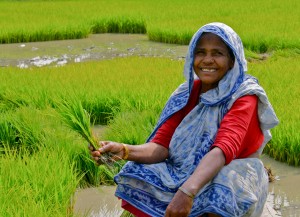| Rucha Chitnis is the South Asia Program Director of Women’s Earth Alliance, a nonprofit that mobilizes resources to grassroots, women-led groups working at the intersection of women’s rights, food sovereignty, and environmental justice. She serves as an advisor to Global Greengrants Fund and recommends grants to support groups in Jharkhand, West Bengal, and beyond. Rucha recently wrote about food security and women’s leadership in “Women in India: How grassroots groups are strengthening food security. |
In the Indian Himalayas a pair of bulls works 1,064 hours, a man 1,212 hours, and a woman 3,485 hours in a year on a one-hectare farm, a figure which illustrates women’s significant contribution to agricultural production. –Food and Agriculture Organization of the United Nations, Sustainable Development Department
Women’s immense contribution to household food security in India remains largely invisible. Yet, the Food and Agriculture Organization estimates that “women produce between 60 and 80 percent of the food in most developing countries and are responsible for half of the world’s food production.” Although the majority of the female workforce in India is engaged in agriculture, most women don’t have land rights.
“Our society thinks that men are farmers,” said one member of the women’s group Maa Durga in the Sundarbans in West Bengal that I visited a few weeks ago. Like many others in the group, she doesn’t own land, yet she labors in the fields day in and day out. “We don’t receive recognition for our farm work. We are looked upon as laborers, but we feel that we are farmers, too.”
Gender discrimination runs deep at many levels: Women manage every aspect of farm work, but are not considered farmers. They toil in the fields—planting, sowing, weeding, and harvesting—but are not landowners. They harvest and process the produce, but men largely control the market and income.

Women are also the primary seed keepers, conserving and managing an incredible variety of India’s vital food crops. But industrial agricultural growth threatens to place these seeds in the hands of seed companies, including large multinational corporations that are motivated primarily by profit.
I also traveled to the farm of Rita Kamila in the Sundarbans. She is known locally as a model woman farmer. Over the past few years, Rita has successfully transitioned her farm to organic. She now grows a stunning diversity of food crops. Rita is also practicing integrated farming with support from Development Research Communications and Service Center, a civil society group that is using a grant from Global Greengrants Fund to build food and livelihood security in poor rural communities. She has incorporated livestock and fish into her farm using ecological principles. Rita has also installed a bio-digester plant that is generating cooking fuel from farm waste, including livestock manure, which is judiciously recycled to provide nutrients to crops.
Rita has gained the respect of her community and often mentors other farmers, who stop by her farm for peer-to-peer exchanges. She said her family has plenty to eat year-round.
“Before, we were dependent on the market. Now, I am selling seeds and produce, and we have more savings. If I am sad, I look at my farm and see the beautiful biodiversity, and it makes me very happy,” she said with a big smile.
Women farmers like Rita Kamila demonstrate that they are crucial drivers of change and can persevere in the face of vulnerabilities.
The world is slowly acknowledging that recognizing women farmers, respecting women’s traditional knowledge, experience, and priorities, and encouraging their ability to innovate on the farm are crucial steps in addressing global food-security challenges.
Funders should consider embracing a gender-justice lens in their grantmaking if their goals are to realize holistic, sustainable development and to promote food security. Gender justice envisions a world that is free from discrimination, in which men and women, both, have equitable access to resources and opportunities, and in which both share power and decision making. A gender-neutrality framework in grantmaking will simply not work—it leads to inefficiencies and is not an optimal use of resources. Besides, in many parts of the world, “gender neutral” means an inherent male bias.
As Elie Weisel wisely said, “Take sides. Neutrality helps the oppressor, never the victim. Silence encourages the tormentor, never the tormented.”
